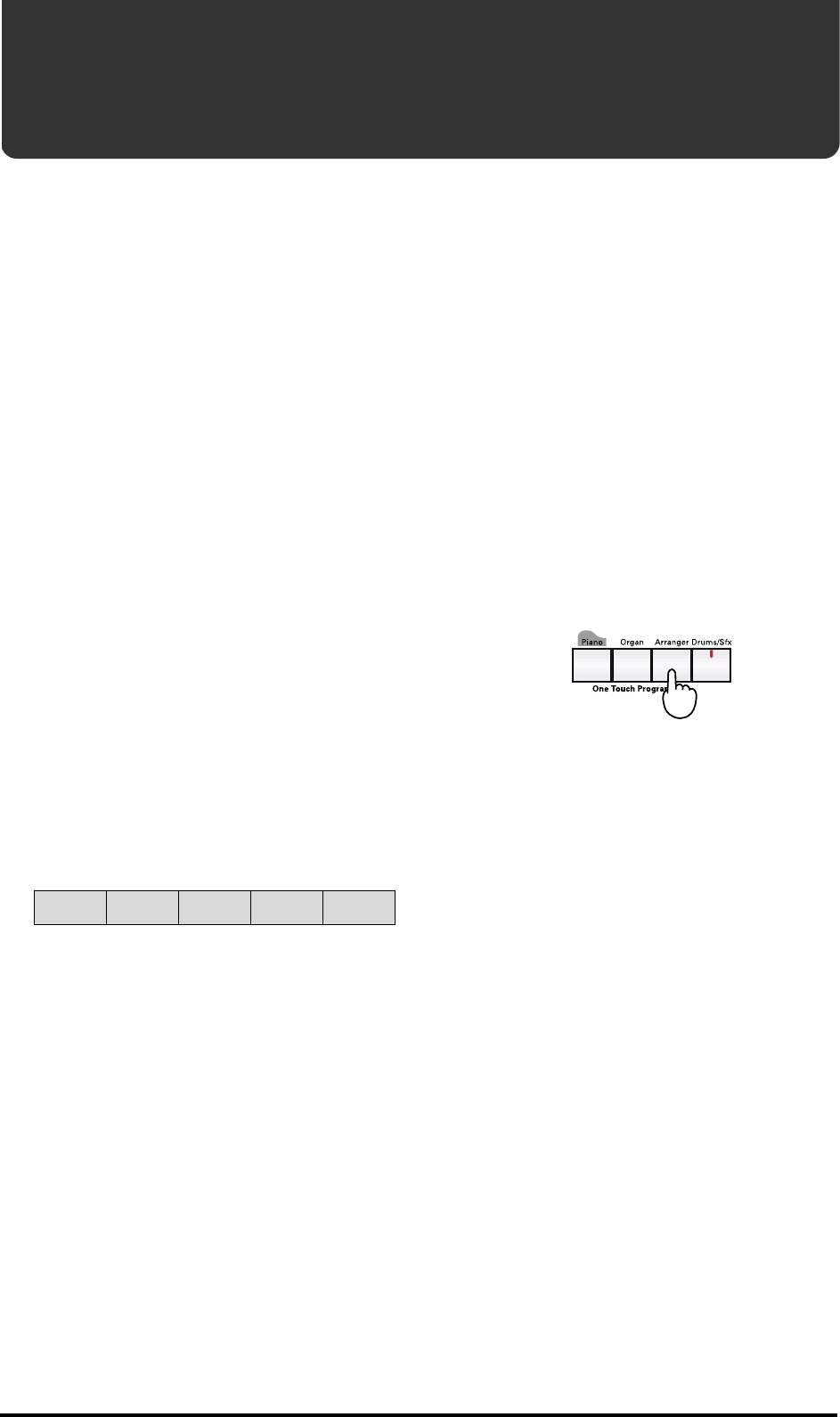
KR-3 Owner’s Manual—Playing with accompaniment (Arranger)
22
7.1 What is an Arranger?
Think of the Arranger’s Music Styles as your backing
band. The following illustration shows that this sug-
gestion is not as preposterous as it may sound because
your KR-3 is capable of playing several “variations”
(called divisions) of a given accompaniment. All you
have to do is make up your mind about the kind of
music you want to play: is it going to be salsa, rhumba,
pop-rock, or big band?
You are the band leader, which means that you have to
tell the members of your band what to play. In other
words, you must explain how many bars there are to
each song part and how the melody and/or solo
should be accompanied.
There are two main levels: Basic and Advanced, each
consisting of two divisions called Original and Varia-
tion.
As its name implies, Basic is the “normal” accompani-
ment level, with only the basic ingredients of a profes-
sional sounding accompaniment. The Advanced level,
on the other hand, may contain another version of the
selected Music Style or just a more elaborate one. On
either level (Basic and Advanced) you can choose
between the Original accompaniment or an alterna-
tive (called Variation). The latter usually adds one or
two parts to the current accompaniment.
As the leader of your band, you have to tell the musi-
cians what to play and when to play it. If you want the
accompaniment to become more complex as the song
evolves, here is a useful sequence:
Other elements help you refine the accompaniment.
Instead of abruptly changing to Advanced/Original,
you may want to play a short transition to announce a
new part of the song. That is what Fill In [TO VARIA-
TION] and [TO ORIGINAL] are for.
See “Switching Style arrangements (divisions)” on
page 26 for other Music Style divisions and functions
you can use to create a professional sounding accom-
paniment.
Each accompaniment (or Music Style) can consist of
up to five parts:
Rhythm— This part takes care of the drums and per-
cussion.
Bass— This part plays the bass line of the selected
Music Style.
Accomp. 1~3— These are the melodic accompani-
ment parts. Depending on the Music Style you
selected, only a few of them actually play something,
which can be anything from a piano line, a guitar line,
an organ line, etc., to a synth pad line.
The bass and accompaniment parts rely on the chord
or note information you play in the chord recognition
area, i.e. the keyboard zone you have assigned to the
Arranger (originally the left half of the keyboard).
Also note that you can use the drum patterns of a
Music Style in other One Touch Program modes
(Piano and Organ). These patterns can be started in
the same way as entire Music Styles (with bass and
melodic accompaniments). See “Starting and stopping
Styles” on page 24.
Settings
Press the One Touch Program [ARRANGER] button.
The KR-3 now automatically makes the following set-
tings:
• The Sync Start function is turned on. This means that
the Arranger will start as soon as you play one or sev-
eral notes with your left hand.
• The Intro function is activated so that Style playback
will start with a musical introduction.
• The keyboard is split at F#3. Use your left hand to
“transpose” the accompaniment pattern(s), and play
the melody with your right hand.
• It selects a suitable (preset) tempo as well as an Upper
Tone for the selected Music Style.
■ Additional notes
• Feel free to change the split point “Lower Tone on/off
and split point” on page 42.
• As in Split mode, the KR-3 automatically selects the
most appropriate pitch for the Tone assigned to the
Upper part. If you want to shift the pitch of the Upper
Tone in octave steps, see “Octave Shift: changing the
pitch by octaves” on page 19.
• See “Auto: changing the Arranger defaults” on page 42
if you don’t want the KR-3 to change the tempo and
select another Upper Tone every time you choose a
Music Style.
7. Playing with accompaniment (Arranger)
Basic
Original
Basic/
Variation
Advanced/
Original
Basic/
Variation
1st Verse 2nd Verse 1st Chorus 3rd Verse
Advanced/
Variation
2nd Chorus
Typical song structure


















